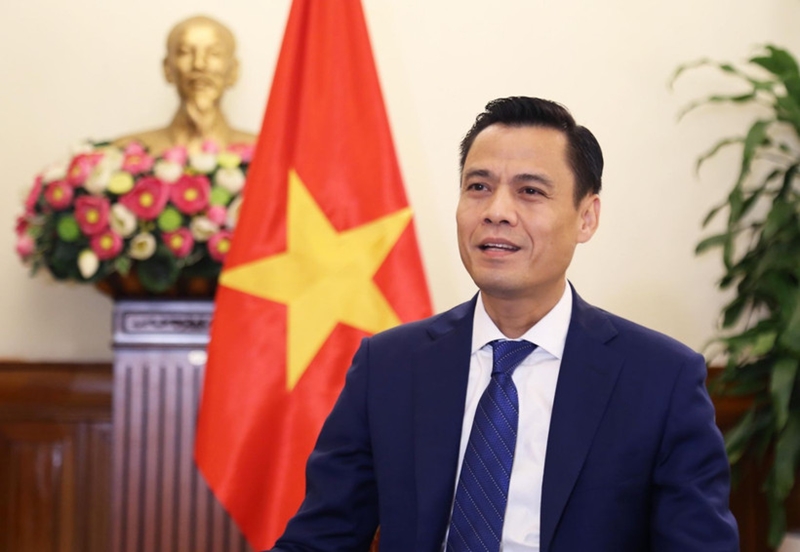This time, Vietnam continued to demonstrate its role as an active and responsible member of the Association of Southeast Asian Nations (ASEAN), and made two important contributions.
    |
 |
|
Deputy Minister of Foreign Affairs Dang Hoang Giang (Photo courtesy of the Ministry of Foreign Affairs) |
First, under Vietnam’s coordination, ASEAN and New Zealand issued a Joint Statement on upgrading their relations to a Comprehensive Strategic Partnership and adopted the 2026–2030 Action Plan to implement the newly established framework.
Second, as Chair of the Initiative for ASEAN Integration (IAI) Task Force, Vietnam led the development of the IAI Work Plan 2026–2030, which was approved at the summit. This document aims to narrow the development gap, strengthen solidarity, and prioritize support for Timor-Leste to catch up with ASEAN’s overall integration process. Vietnam’s role and efforts were sincerely appreciated and highly valued by other member countries, Giang stated.
In these shared successes, PM Chinh’s insightful, sincere, and straightforward remarks at the summits emphasized the importance of peace and stability as a prerequisite for development, highlighted the significance of ASEAN unity, and reaffirmed Vietnam’s commitment to contributing to the bloc for the practical benefit of its people and businesses.
The PM's views, especially his proposal that ASEAN fully harness three strategic resources of the strength of solidarity, the vitality of dynamism, and the momentum of innovation were well received and praised by member states and partners for the sense of responsibility, soundness of content, and practical, effective approach to implementation.
The deputy minister went on the say that in just three days in Kuala Lumpur, PM Pham Minh Chinh held bilateral meetings and exchanges with leaders from more than 20 partners, including all ASEAN member states, major partners, and regional and international organizations. Though brief, these meetings produced many concrete and substantive outcomes.
First, political trust between Vietnam and these countries was further strengthened. All partners expressed their desire to enhance relations with Vietnam. The fact that U.S. President Donald Trump, Chinese Premier Li Qiang, newly elected Japanese PM Sanae Takaichi, Brazilian President Lula da Silva, Canadian PM Mark Carney, and many other leaders agreed with Vietnam’s proposal to increase high-level exchanges in the coming time demonstrates that these countries highly value Vietnam’s role in the region, and also support a stable, developing Vietnam which is playing an increasingly important role in ASEAN and on the international stage.
Second, Vietnam and its key strategic partners reached broad consensus on many important issues, reflecting their shared interests. Chinese Premier Li Qiang agreed to actively promote the ground-breaking of the Hanoi – Hai Phong – Lao Cai high-speed railway project. The Canadian PM announced that his country will soon launch a 20-million-USD coastal smart city project designed to enhance resilience to natural disasters and climate change. World Bank Vice President Carlos Felipe Jaramillo affirmed the bank’s readiness to respond to Vietnam’s requests for faster and more effective resource mobilization to support its socio-economic development goals. Notably, a major highlight of this occasion was the announcement of the Joint Statement on a U.S. - Vietnam Framework for an Agreement on Reciprocal, Fair, and Balanced Trade on October 26.
These developments mark significant progress, helping to lay a stable and sustainable foundation for Vietnam’s relations with its key partners and mobilize additional external resources to realize the country’s strategic goals, particularly the target of achieving double-digit growth after the 14th National Party Congress.
Third, through the discussions, it became evident that partners truly support and expect Vietnam to play a greater role in ASEAN, in the Asia–Pacific region, and on the global stage. Leaders of many countries and international organizations expressed strong impressions of Vietnam’s remarkable development over the past decades. They also affirmed their appreciation of Vietnam’s role and position, while expressing their wish for Vietnam to help promote cooperation between their countries and ASEAN. These demonstrate that Vietnam is viewed as one of ASEAN’s key and capable member states, with the potential to assume a leading role within the bloc.
In the context of Vietnam’s strong implementation of the Politburo’s Resolution No. 59 on international integration in the new situation and efforts to elevate multilateral diplomacy, the trust and support from international friends constitute a precious source of "political capital," enabling it to make even greater contributions to global politics, the world economy, and human civilization, Giang said.
Regarding specific orientations for implementing the outcomes of Vietnam’s participation in this ASEAN Summit, the official stressed that Vietnam needs to make active contributions to strengthening ASEAN's solidarity, particularly in efforts to address the Myanmar issue, implement the peace deal between Cambodia and Thailand, and help maintain a peaceful, stable, and favorable environment for ASEAN. At the same time, Vietnam should continue pursuing the long-term goals set out in the ASEAN Community Vision 2045 (ACV 2045), and focus on supporting Timor-Leste in enhancing its capacity and effectively integrating into ASEAN across all three pillars.
It is also essential to promptly implement the agreements and commitments reached between Vietnam and its partners during bilateral meetings on the sidelines of the summit, including exchanges of delegations, promotion of economic and trade cooperation, food and energy security, and especially the prompt settlement of outstanding issues to have the E.U.’s yellow card warning on Vietnamese seafood lifted, Giang said, urging ministries, sectors, localities, and enterprises to work closely, proactively, and swiftly to ensure the comprehensive and effective implementation of the outcomes achieved with partners.
Source: VNA